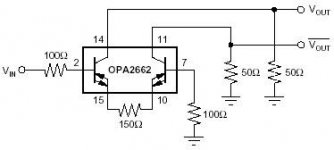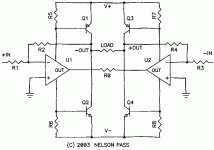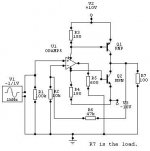Op amps being what they are, if you set it at 0, it
will probably oscillate. On the other hand, at 1 Kohm,
you might see more distortion than you like.
Best guess offhand? 100 ohms.
Better way? Find the highest value that still causes
oscillation and multiply by 5 to 10.
Like with the resistance to ground on the inputs of the
X and Aleph X amps, there will be an alteration in sound
as you adjust this. I think similar thing occurs in the Aleph P
and BSOZ circuit: there is apparently an optimal sonic value,
and it is not the same as the least distortion value.
will probably oscillate. On the other hand, at 1 Kohm,
you might see more distortion than you like.
Best guess offhand? 100 ohms.
Better way? Find the highest value that still causes
oscillation and multiply by 5 to 10.
Like with the resistance to ground on the inputs of the
X and Aleph X amps, there will be an alteration in sound
as you adjust this. I think similar thing occurs in the Aleph P
and BSOZ circuit: there is apparently an optimal sonic value,
and it is not the same as the least distortion value.
Re: Bridging amplifiers
Actually I’m not sure if I missed something here or not. But I do know that this configuration is very similar to one of my discrete line driver, Op amp circuits in which I utilize both current and voltage feedback. Current feedback is applied to the drivers and voltage feedback to the front end. When used in its balanced configuration it gives the same basic results as the circuit described at the top of this thread since it provides cross-coupled voltage and current feedback paths. Simulations had shown that such a arrangement had some worth while benefits.
There are circuit differences of course, but the basic idea is the same. Apply both current and voltage feedback to help induce the most linear operation possible over the widest possible frequency range with good phase margins. In my version each side has a plus and minus input since the input stage is a differential pair. Thus there are four inputs and two outputs. It was fairly simple to add the desired current feedback during the design process since it was all discrete components. This wide band gain module is to be offered in kit form some time in the future.
John Fassotte
Alaskan Audio
Nelson Pass said:
In point of fact there is something new here, and you seem
to have missed the essence of it.
Actually I’m not sure if I missed something here or not. But I do know that this configuration is very similar to one of my discrete line driver, Op amp circuits in which I utilize both current and voltage feedback. Current feedback is applied to the drivers and voltage feedback to the front end. When used in its balanced configuration it gives the same basic results as the circuit described at the top of this thread since it provides cross-coupled voltage and current feedback paths. Simulations had shown that such a arrangement had some worth while benefits.
There are circuit differences of course, but the basic idea is the same. Apply both current and voltage feedback to help induce the most linear operation possible over the widest possible frequency range with good phase margins. In my version each side has a plus and minus input since the input stage is a differential pair. Thus there are four inputs and two outputs. It was fairly simple to add the desired current feedback during the design process since it was all discrete components. This wide band gain module is to be offered in kit form some time in the future.
John Fassotte
Alaskan Audio
Well,to my eyes it seems that Nelson's new idea is really awsome,although it is made of all points for a good sound recipe,known of all audiophiles,but true the application is new.
I wonder why I have never seen current feedback in Alephs.Such an approch is dangerous for the sound,but if mated can give good results.
I believe that Alephs were simple circuits enough not to require the application of current feedback to achieve good performance.Here to my opinion simpler is better ...Thanks Nelson.
I have seen schematics using the classic feeback plus a current feedback arranged in non true-balanced amplification modules,such as Accuphase.But first time I see benefits mixed from a crossed coupled differential error correction associated with a current feedback path between an arrangenment of 2 balanced circuits.
I really believe that an optimized prototype would work,sonnically well even if distortion numbers would rather be higher.
Nelson opens our minds to a new technique providing the best of the 2 approchs:Su-sy with added current feedback between 2 modules.Wouldn'it be a X current feedback under Su-sy?
But I am already sure that you have already prototyped it,Nelson...in the noble and discrete way ?
Best regards
Anael
I wonder why I have never seen current feedback in Alephs.Such an approch is dangerous for the sound,but if mated can give good results.
I believe that Alephs were simple circuits enough not to require the application of current feedback to achieve good performance.Here to my opinion simpler is better ...Thanks Nelson.
I have seen schematics using the classic feeback plus a current feedback arranged in non true-balanced amplification modules,such as Accuphase.But first time I see benefits mixed from a crossed coupled differential error correction associated with a current feedback path between an arrangenment of 2 balanced circuits.
I really believe that an optimized prototype would work,sonnically well even if distortion numbers would rather be higher.
Nelson opens our minds to a new technique providing the best of the 2 approchs:Su-sy with added current feedback between 2 modules.Wouldn'it be a X current feedback under Su-sy?

But I am already sure that you have already prototyped it,Nelson...in the noble and discrete way ?

Best regards
Anael
Nelson Pass said:
"current feedback" op amps
Is LM6181 (http://www.national.com/ds/LM/LM6181.pdf) suitable?
JH
Re: Re: Monolithic SuperSymmetry with Current Feedback
look like a circuit you've seen elsewhere? If so, where?
I should point out that I don't consider the circuit as using
current feedback. It simply uses the current feedback port
to communicate between the symmetric pair.
I wrote it up. I recall that there is also a dual part made
by National which might be even more convenient, but I
can't find it now. In any case, any "current feedback" op
amp will probably do the job.
What we need is a high power op amp with this type of
input, and we can compete with the gain-cloners!

Have a look at jh6you's schematics on this thread. Does thisalaskanaudio said:But I do know that this configuration is very similar to one of my discrete line driver, Op amp circuits in which I utilize both current and voltage feedback.
look like a circuit you've seen elsewhere? If so, where?
I should point out that I don't consider the circuit as using
current feedback. It simply uses the current feedback port
to communicate between the symmetric pair.
Absolutely, in fact this is the part # I was looking at whenjh6you said:Is LM6181 (http://www.national.com/ds/LM/LM6181.pdf) suitable?J
I wrote it up. I recall that there is also a dual part made
by National which might be even more convenient, but I
can't find it now. In any case, any "current feedback" op
amp will probably do the job.
What we need is a high power op amp with this type of
input, and we can compete with the gain-cloners!

Re: Re: Re: Monolithic SuperSymmetry with Current Feedback
that's why my simulations were giving me 60nv pp output . I was using classical opamps
. I was using classical opamps
current feedback, ok...Nelson Pass said:
Have a look at jh6you's schematics on this thread. Does this
look like a circuit you've seen elsewhere? If so, where?
I should point out that I don't consider the circuit as using
current feedback. It simply uses the current feedback port
to communicate between the symmetric pair.
Absolutely, in fact this is the part # I was looking at when
I wrote it up. I recall that there is also a dual part made
by National which might be even more convenient, but I
can't find it now. In any case, any "current feedback" op
amp will probably do the job.
What we need is a high power op amp with this type of
input, and we can compete with the gain-cloners!

that's why my simulations were giving me 60nv pp output
nar said:I wonder why I have never seen current feedback in Alephs.Such an approach is dangerous for the sound,but if mated can give good results.
I would have to offer up the notion that an Aleph current
source would be considered a form of current feedback by
itself, although not in the sense you mean.
There is no reason that you could not use current feedback in
the front end of an Aleph.
Shall I start a new thread with such a project? What do I hear?
(voice from the crowd shouts, "That's metaphysically impossible!
How can I know what You hear")

Re: Re: Re: Monolithic SuperSymmetry with Current Feedback
Don't see much chance of that happening. Why not use the X circuit to drive a simple follower. I mean, you're already going to have to use more than one opamp so why not just add a few discrete parts and make it a hybrid?
se
Nelson Pass said:What we need is a high power op amp with this type of
input, and we can compete with the gain-cloners!
Don't see much chance of that happening. Why not use the X circuit to drive a simple follower. I mean, you're already going to have to use more than one opamp so why not just add a few discrete parts and make it a hybrid?
se
Nelson, you have a great knack for re-energizing the forum when things start to get a little dull. This new thing might be a good front-end for a MOSFET circlotron output stage such as this one:
Class A MOSFET Circlotron
Moderator: Please. This is not threadjacking. It is specifically applicable to the discussion at hand. Shameless, perhaps, but germane! Okay, I confess I'm digging for hints on biasing the circlotron use fets of the IR variety. My dream of the X-Circlotron will see the light of day! Which reminds me... if only I could work some lightbulbs in....
Mike
Class A MOSFET Circlotron
Moderator: Please. This is not threadjacking. It is specifically applicable to the discussion at hand. Shameless, perhaps, but germane! Okay, I confess I'm digging for hints on biasing the circlotron use fets of the IR variety. My dream of the X-Circlotron will see the light of day! Which reminds me... if only I could work some lightbulbs in....
Mike
I'm not sure there is a market - at least not a large enough market to justify an IC development. Current feedback opamps have generally been designed for leading-edge bandwidth applications (GHz), where parasitics can limit the stability of voltage-feedback opamps. As new voltage-feedback opamps come out on newer processes, without stability problems, they seem to supplant the current-feedback opamps in those applications.Originally posted by Nelson Pass
I haven't yet run across an example of a monolithic higher power op amp using current feedback on the market, but there is no reason that one would not exist.
The “current feedback” appellation is confusing; I believe the correct term is “operational transconductance amplifier”
For (low power) monolithic implementation see TI/BB OPA2662 and the app note sboa047.pdf “New Ultra High Speed Circuit Techniques with Analog ICs”
See fig 10 “Single Ended-to-Differential Line Driver” in the 2662 data sheet, add 2 feedback resistors as has long been done in differential output amplifiers and you have the supersymmetry/active X:
For (low power) monolithic implementation see TI/BB OPA2662 and the app note sboa047.pdf “New Ultra High Speed Circuit Techniques with Analog ICs”
See fig 10 “Single Ended-to-Differential Line Driver” in the 2662 data sheet, add 2 feedback resistors as has long been done in differential output amplifiers and you have the supersymmetry/active X:
jcx said:See fig 10 “Single Ended-to-Differential Line Driver” in the 2662 data sheet, add 2 feedback resistors as has long been done in differential output amplifiers and you have the supersymmetry/active X:
Indeed you do. Have you previously seen the addition
of symmetric feedback to this circuit, and if so, where?
BTW, the polarity of Vout is inverted from Vin in the
diagram posted.
While we're on the subject, here is Yet Another Monolithic
X circuit (YAMX). Shown below is a simplified schematic.
This one can be constructed using conventional op amps
and does not require "current feedback" types.
Actually it emulates them by using the output of the
op amps as the "current feedback" terminal.
It is power scalable, obviously because it uses external
power transistors.
enjoy.
X circuit (YAMX). Shown below is a simplified schematic.
This one can be constructed using conventional op amps
and does not require "current feedback" types.
Actually it emulates them by using the output of the
op amps as the "current feedback" terminal.
It is power scalable, obviously because it uses external
power transistors.
enjoy.
Attachments
Nelson Pass said:While we're on the subject, here is Yet Another Monolithic
X circuit (YAMX). Shown below is a simplified schematic.
This one can be constructed using conventional op amps
and does not require "current feedback" types.
Actually it emulates them by using the output of the
op amps as the "current feedback" terminal.
It is power scalable, obviously because it uses external
power transistors.
enjoy.
Unfortunately , I am not able to open/see the attachment .
Please moderators , come in !!

Thank You
Wireless World ckt
Many years ago I saw the circuit attached below in Wireless World magazine. It was a suggestion to increase the output capability of an opamp. I don't remember the resistor values. This must have been in the Circuit Ideas section I think.
The circuit in yax.1bmp looks like a bridged inverting version of this circuit.
Many years ago I saw the circuit attached below in Wireless World magazine. It was a suggestion to increase the output capability of an opamp. I don't remember the resistor values. This must have been in the Circuit Ideas section I think.
The circuit in yax.1bmp looks like a bridged inverting version of this circuit.
Attachments
- Status
- This old topic is closed. If you want to reopen this topic, contact a moderator using the "Report Post" button.
- Home
- Amplifiers
- Pass Labs
- Monolithic SuperSymmetry with Current Feedback


